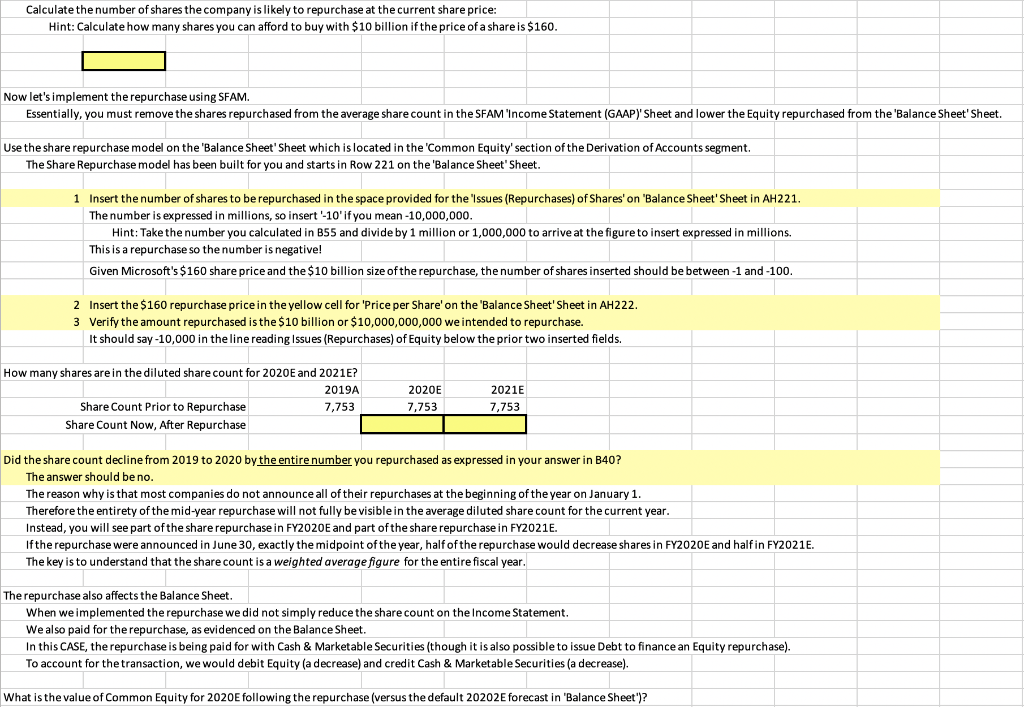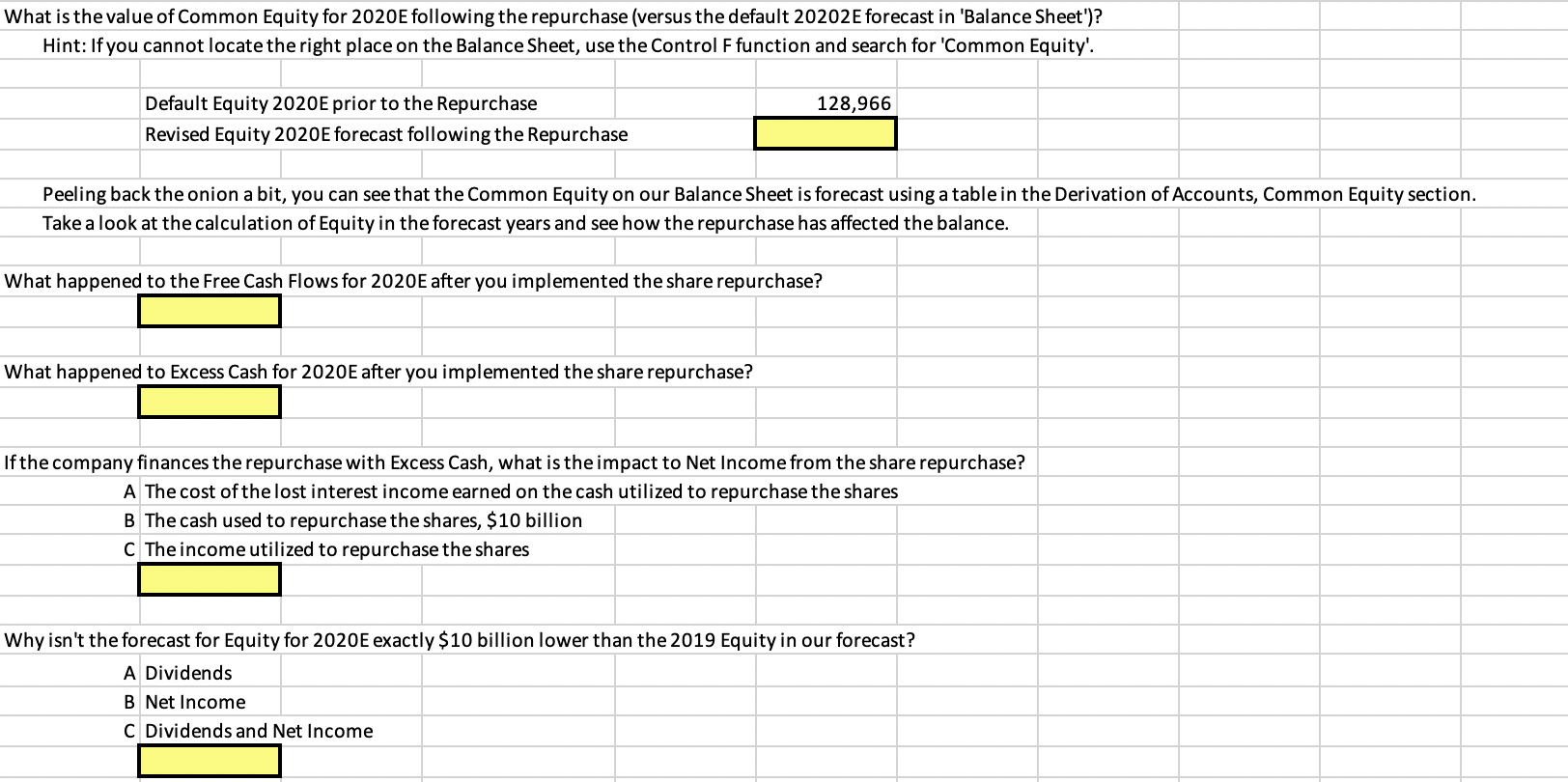


In this CASE we are going to implement a share repurchase. We will utilize all three of the major financial statements. Please start this assignment with the forecast for 2020 and 2021E set to the consensus revenues and EPS we used in the last CASE Simple Forecast. In CASE Simple Forecast, row 138, we found the consensus forecast for Microsoft (MSFT): High Mean 152.0 6.00 142.2 5.66 Low 2020E Revenues $B 139.4 EPS 5.46 2021E Revenues $B 153.2 EPS 5.52 Source: CNN Money, 3/16/20 168.7 7.11 159.7 6.30 Typically, the analyst will see an announcement such as the following: The Board has approved a share repurchase program of $10 billion and these repurchases will be primarily financed through free cash flow. (3/10/20) First let's consider whether the company has the cash in place to execute the repurchase or whether it may need to seek outside financing. (In recent years, many companies have taken advantage of low interest rates and borrowed money, raising Debt, to finance share repurchases.) In this instance, the company has announced it will self finance the repurchase. Other times, the company may not indicate how it is financing the repurchase and the analyst will determine whether it will be through: (a) Cash on hand (Excess Cash on the Balance Sheet) (b) projected Free Cash Flows (c) new Debt financing The 'Cash Flow Statement' Sheet will automatically calculate Free Cash Flows based on your Income Statement and Balance Sheet forecasts. As a reminder, we already used the 'Income Statement (GAAP)' Sheet to forecast 2020E and 2021E earnings in line with the consensus forecast for revenues and earnings. Our Balance Sheet forecasts are set at the default levels, which rise and fall with the forecast for Revenues. How much Free Cash Flow do you forecast Microsoft will generate in FY2020E ($ Millions)? Do you think Microsoft can self finance this repurchase with its Free Cash Flows? Second, let's determine how many shares Microsoft will repurchase with $10 billion? Find the closing price of MSFT stock on 3/10/20, the day of the announcement. Let's say 'the close' on the day of the announcement is: $160 / share. We do not want to forecast the repurchase price and instead will assume the current close is the repurchase price. (This is what a working financial analyst on Wall Street would do.) Calculate the number of shares the company is likely to repurchase at the current share price: Hint: Calculate how many shares you can afford to buy with $10 billion if the price of a share is $160. Now let's implement the repurchase using SFAM. Essentially, you must remove the shares repurchased from the average share count in the SFAM 'Income Statement (GAAP)' Sheet and lower the Equity repurchased from the 'Balance Sheet'Sheet. Use the share repurchase model on the 'Balance Sheet' Sheet which is located in the Common Equity' section of the Derivation of Accounts segment. The Share Repurchase model has been built for you and starts in Row 221 on the 'Balance Sheet' Sheet. 1 Insert the number of shares to be repurchased in the space provided for the 'Issues (Repurchases) of Shares' on 'Balance Sheet'Sheet in AH221. The number is expressed in millions, so insert '-10' if you mean -10,000,000. Hint: Take the number you calculated in B55 and divide by 1 million or 1,000,000 to arrive at the figure to insert expressed in millions. This is a repurchase so the number is negative! Given Microsoft's $160 share price and the $10 billion size of the repurchase, the number of shares inserted should be between-1 and -100. 2 Insert the $160 repurchase price in the yellow cell for 'Price per Share' on the 'Balance Sheet' Sheet in AH222. 3 Verify the amount repurchased is the $10 billion or $10,000,000,000 we intended to repurchase. It should say -10,000 in the line reading Issues (Repurchases) of Equity below the prior two inserted fields. How many shares are in the diluted share count for 2020 and 2021E? 2019A Share Count Prior to Repurchase 7,753 Share Count Now, After Repurchase 2020E 7,753 2021E 7,753 Did the share count decline from 2019 to 2020 by the entire number you repurchased as expressed in your answer in B40? The answer should be no. The reason why is that most companies do not announce all of their repurchases at the beginning of the year on January 1. Therefore the entirety of the mid-year repurchase will not fully be visible in the average diluted share count for the current year. Instead, you will see part of the share repurchase in FY2020E and part of the share repurchase in FY2021E. If the repurchase were announced in June 30, exactly the midpoint of the year, half of the repurchase would decrease shares in FY2020E and half in FY2021E. The key is to understand that the share count is a weighted average figure for the entire fiscal year. The repurchase also affects the Balance Sheet. When we implemented the repurchase we did not simply reduce the share count on the Income Statement. We also paid for the repurchase, as evidenced on the Balance Sheet. In this CASE, the repurchase is being paid for with Cash & Marketable Securities (though it is also possible to issue Debt to finance an Equity repurchase). To account for the transaction, we would debit Equity (a decrease) and credit Cash & Marketable Securities (a decrease). What is the value of Common Equity for 2020E following the repurchase (versus the default 20202E forecast 'Balance Sheet')? What is the value of Common Equity for 2020E following the repurchase (versus the default 20202E forecast in 'Balance Sheet')? Hint: If you cannot locate the right place on the Balance Sheet, use the Control F function and search for 'Common Equity'. 128,966 Default Equity 2020E prior to the Repurchase Revised Equity 2020E forecast following the Repurchase Peeling back the onion a bit, you can see that the Common Equity on our Balance Sheet is forecast using a table in the Derivation of Accounts, Common Equity section. Take a look at the calculation of Equity in the forecast years and see how the repurchase has affected the balance. What happened to the Free Cash Flows for 2020E after you implemented the share repurchase? What happened to Excess Cash for 2020E after you implemented the share repurchase? If the company finances the repurchase with Excess Cash, what is the impact to Net Income from the share repurchase? A The cost of the lost interest income earned on the cash utilized to repurchase the shares B The cash used to repurchase the shares, $10 billion C The income utilized to repurchase the shares Why isn't the forecast for Equity for 2020E exactly $10 billion lower than the 2019 Equity in our forecast? A Dividends B Net Income C Dividends and Net Income In this CASE we are going to implement a share repurchase. We will utilize all three of the major financial statements. Please start this assignment with the forecast for 2020 and 2021E set to the consensus revenues and EPS we used in the last CASE Simple Forecast. In CASE Simple Forecast, row 138, we found the consensus forecast for Microsoft (MSFT): High Mean 152.0 6.00 142.2 5.66 Low 2020E Revenues $B 139.4 EPS 5.46 2021E Revenues $B 153.2 EPS 5.52 Source: CNN Money, 3/16/20 168.7 7.11 159.7 6.30 Typically, the analyst will see an announcement such as the following: The Board has approved a share repurchase program of $10 billion and these repurchases will be primarily financed through free cash flow. (3/10/20) First let's consider whether the company has the cash in place to execute the repurchase or whether it may need to seek outside financing. (In recent years, many companies have taken advantage of low interest rates and borrowed money, raising Debt, to finance share repurchases.) In this instance, the company has announced it will self finance the repurchase. Other times, the company may not indicate how it is financing the repurchase and the analyst will determine whether it will be through: (a) Cash on hand (Excess Cash on the Balance Sheet) (b) projected Free Cash Flows (c) new Debt financing The 'Cash Flow Statement' Sheet will automatically calculate Free Cash Flows based on your Income Statement and Balance Sheet forecasts. As a reminder, we already used the 'Income Statement (GAAP)' Sheet to forecast 2020E and 2021E earnings in line with the consensus forecast for revenues and earnings. Our Balance Sheet forecasts are set at the default levels, which rise and fall with the forecast for Revenues. How much Free Cash Flow do you forecast Microsoft will generate in FY2020E ($ Millions)? Do you think Microsoft can self finance this repurchase with its Free Cash Flows? Second, let's determine how many shares Microsoft will repurchase with $10 billion? Find the closing price of MSFT stock on 3/10/20, the day of the announcement. Let's say 'the close' on the day of the announcement is: $160 / share. We do not want to forecast the repurchase price and instead will assume the current close is the repurchase price. (This is what a working financial analyst on Wall Street would do.) Calculate the number of shares the company is likely to repurchase at the current share price: Hint: Calculate how many shares you can afford to buy with $10 billion if the price of a share is $160. Now let's implement the repurchase using SFAM. Essentially, you must remove the shares repurchased from the average share count in the SFAM 'Income Statement (GAAP)' Sheet and lower the Equity repurchased from the 'Balance Sheet'Sheet. Use the share repurchase model on the 'Balance Sheet' Sheet which is located in the Common Equity' section of the Derivation of Accounts segment. The Share Repurchase model has been built for you and starts in Row 221 on the 'Balance Sheet' Sheet. 1 Insert the number of shares to be repurchased in the space provided for the 'Issues (Repurchases) of Shares' on 'Balance Sheet'Sheet in AH221. The number is expressed in millions, so insert '-10' if you mean -10,000,000. Hint: Take the number you calculated in B55 and divide by 1 million or 1,000,000 to arrive at the figure to insert expressed in millions. This is a repurchase so the number is negative! Given Microsoft's $160 share price and the $10 billion size of the repurchase, the number of shares inserted should be between-1 and -100. 2 Insert the $160 repurchase price in the yellow cell for 'Price per Share' on the 'Balance Sheet' Sheet in AH222. 3 Verify the amount repurchased is the $10 billion or $10,000,000,000 we intended to repurchase. It should say -10,000 in the line reading Issues (Repurchases) of Equity below the prior two inserted fields. How many shares are in the diluted share count for 2020 and 2021E? 2019A Share Count Prior to Repurchase 7,753 Share Count Now, After Repurchase 2020E 7,753 2021E 7,753 Did the share count decline from 2019 to 2020 by the entire number you repurchased as expressed in your answer in B40? The answer should be no. The reason why is that most companies do not announce all of their repurchases at the beginning of the year on January 1. Therefore the entirety of the mid-year repurchase will not fully be visible in the average diluted share count for the current year. Instead, you will see part of the share repurchase in FY2020E and part of the share repurchase in FY2021E. If the repurchase were announced in June 30, exactly the midpoint of the year, half of the repurchase would decrease shares in FY2020E and half in FY2021E. The key is to understand that the share count is a weighted average figure for the entire fiscal year. The repurchase also affects the Balance Sheet. When we implemented the repurchase we did not simply reduce the share count on the Income Statement. We also paid for the repurchase, as evidenced on the Balance Sheet. In this CASE, the repurchase is being paid for with Cash & Marketable Securities (though it is also possible to issue Debt to finance an Equity repurchase). To account for the transaction, we would debit Equity (a decrease) and credit Cash & Marketable Securities (a decrease). What is the value of Common Equity for 2020E following the repurchase (versus the default 20202E forecast 'Balance Sheet')? What is the value of Common Equity for 2020E following the repurchase (versus the default 20202E forecast in 'Balance Sheet')? Hint: If you cannot locate the right place on the Balance Sheet, use the Control F function and search for 'Common Equity'. 128,966 Default Equity 2020E prior to the Repurchase Revised Equity 2020E forecast following the Repurchase Peeling back the onion a bit, you can see that the Common Equity on our Balance Sheet is forecast using a table in the Derivation of Accounts, Common Equity section. Take a look at the calculation of Equity in the forecast years and see how the repurchase has affected the balance. What happened to the Free Cash Flows for 2020E after you implemented the share repurchase? What happened to Excess Cash for 2020E after you implemented the share repurchase? If the company finances the repurchase with Excess Cash, what is the impact to Net Income from the share repurchase? A The cost of the lost interest income earned on the cash utilized to repurchase the shares B The cash used to repurchase the shares, $10 billion C The income utilized to repurchase the shares Why isn't the forecast for Equity for 2020E exactly $10 billion lower than the 2019 Equity in our forecast? A Dividends B Net Income C Dividends and Net Income









